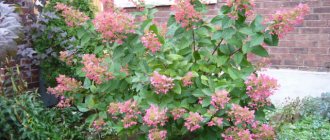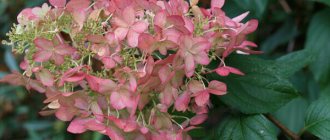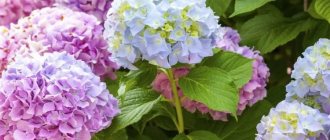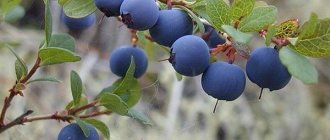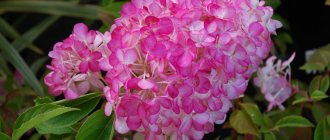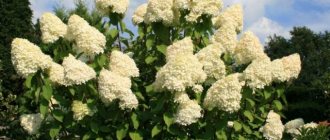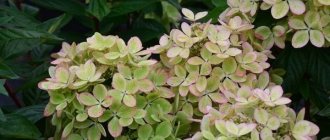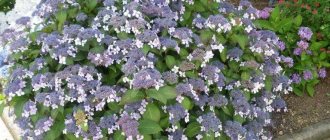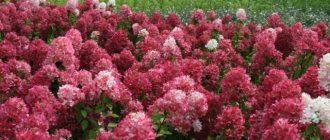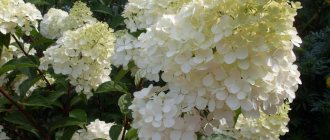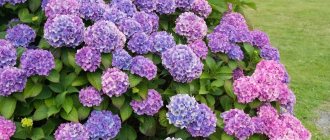Hydrangea Pink Annabelle is a young variety of tree hydrangea, characterized by hardiness and resistance to winter frosts. It looks like a large bush up to 1.5 m in height and almost 1 m in width. At first it blooms in different shades of pink, but by mid-summer it “determines” its color – light or dark pink.
Pink Annabelle is one of the hardiest hydrangea varieties.
Description of Hydrangea tree Pink Annabel
Tree hydrangea (hydrangea arborescens pink annabelle) is a new variety of the Annabelle hydrangea species. It is considered the most durable, unlike its predecessors. Height and width are approximately 90-120 cm. Strong shoots do not press to the ground, despite the heavy, massive buds.
The inflorescences consist of a large number of flowers, externally spherical in shape, pink in color. At the beginning of flowering, the upper petals are pale pink, and closer to the base they are dark pink. Over time, the gradient effect disappears, leaving a light or dark color of the inflorescences.
Flowering is long, from about the beginning of summer until frost.
Origin and appearance of Pink Annabelle hydrangea
Hydrangea Pink Annabelle is an artificially bred plant variety. The birthplace of selection is America, the time of its appearance is the 18th century. The plant quickly gained popularity, so within a few years it appeared in Europe.
The selection product has, according to its name, bright pink inflorescences. Plants feel best in central Russia and in the south of the country.
Blooming hydrangea Pink Annabelle
The plant is distinguished by strong shoots, thanks to which even if there are many inflorescences on the stem, they do not bend to the ground. The seedlings are tall, 1-1.5 m. The diameter of the bush can reach 3 m. The shoots are fast-growing; they gain 20 cm in height over the season.
The leaves are dark green, oval, with mottled edges up to 20 cm long. In autumn they turn yellow and fall off. The height of the bush does not exceed 1.2 m. The variety is suitable both for single cultivation and for complementing other garden crops.
The bush can grow in one place for up to half a century. Despite the need to feed the plant, if this is not done, the shoots do not stop growing.
How Pink Annabelle hydrangea blooms
The plant is a long-flowering plant, pleasing to the eye with flowers from early summer to autumn. The possibility of flowering depends on the conditions in which it grows.
According to the description of the variety, the small flowers of the plant are collected in a lush round inflorescence with a diameter of up to 30-40 cm. At first, after full bloom, the caps have a dark pink color, then as the season progresses they lighten.
The Annabelle plant is distinguished by its amazing ability to change color depending on the composition of the soil. For example, white can turn into blue if there is a lot of aluminum in the soil. If you use a solution of this element for a pink bud, it turns purple.
Important ! The peculiarity of the variety is that flowering is possible only on young shoots of the first year of life.
Hydrangea Pink Anabel in landscape design
Tree hydrangea Pink Annabelle, as seen in the photo below, is widely used in landscape design.
Hydrangea is planted on the site in recreational areas, along with the lawn or perennial plantings, in the garden and front gardens
Use tree hydrangea separately or arrange group plantings with other species of this plant.
Reproduction methods
For tree hydrangea, gardeners use several propagation methods.
Pink Anabel variety of tree hydrangea
Cuttings
Cuttings are cut in the fall during sanitary cutting. At the top of the stems, select the strongest branches with several leaves and buds. The shoots of the current year that have not bloomed have the best survival rate. The optimal length is 15-20 cm.
In the lower part, all foliage is removed, then dipped in one of the growth stimulants for an hour. After this time, they are planted in a light, loose and well-moistened mixture of peat and sand. Planting depth is 3-4 cm. Each cutting is covered with half a transparent plastic bottle to create a greenhouse effect.
Before the onset of persistent cold weather, the seedlings are covered with burlap or agrofibre. When grown in a harsh climate zone, it is better to dig them up and transplant them into pots. In May, when the threat of return frosts has passed, it should be returned to its original habitat in the open ground.
Stem layering
Hydrangea pink anabelle successfully reproduces by layering. Choose an adult bush with good branching. A shallow trench (5-6 cm) is dug next to it. Sprinkle with a mixture of peat, sand and humus (1:1:1). Select the most flexible branch closest to the ground. Remove all the leaves on it, lower it horizontally into the groove, and pin it with staples. Sprinkle the branch with the remaining fertile soil and water it.
A week before persistent cold weather, cover with fallen leaves, pine sawdust or spruce branches. This will create additional protection against freezing in winter.
With the arrival of spring, when the snow thaws and the street heat stabilizes, the branch is dug up and cut off from the mother bush. Divide into several parts with roots, plant on the site according to the above described scheme.
Dividing the bush
This method is used for old plants that need rejuvenation. You can determine that a bush needs to be rejuvenated by its general condition - it stops growing, blooms sparingly, or does not produce inflorescences at all.
First, water the hydrangea abundantly, and after an hour, carefully dig it in to prevent injury to the roots. Remove and wash the root system under running water. Let it dry a little, then divide it into several parts with a garden shovel. It is important that each division has 2-3 shoots and roots left.
To avoid infection, the cut sites are treated with copper sulfate, and after drying, they are planted on the site.
Winter hardiness of hydrangea variety Pink Anabel
Most types of hydrangea require greenhouse conditions for the winter period, which include insulating the soil, covering the bush with several layers of polyethylene, etc. However, with tree varieties everything is simpler; they tolerate winter well. Only minor hilling is required, as well as pruning of faded inflorescences. The latter is done for the reason that the shoots may break under the weight of snow. On the other hand, if the grower is ready to regularly shake off the accumulating snow on the plant, then there is no need to trim the inflorescences. Moreover, thanks to their integrity, the buds located inside the bush will be better preserved.
Non-woody shoots require special attention; they should be cut off, as they will not survive the winter.
Planting and caring for tree hydrangea Pink Annabel
In general, the tree hydrangea of the Pink Annabelle variety does not require intricate planting and care techniques. She prefers moisture, does not like scorching sun rays, and tolerates wintering well. Regular watering, insulating the roots for the winter, and feeding the soil will ensure colorful flowering of hydrangeas for many years.
Selection and preparation of a landing site
The landing site is of great importance. With the right choice, the plant will delight the grower for many years. The main thing is that the selected landscape is protected from strong gusts of wind and drafts.
Hydrangea can be planted next to a high fence or ornamental trees; they will serve as protection from drafts. In addition, the species does not like direct scorching sun, although it needs a sufficient amount of it. All the same trees will help protect the plant from direct sunlight.
However, hydrangea is moisture-loving, which means it will not like trees with a large root system that will “steal” water from it. Dry soil can cause it to simply not bloom. However, if the grower can provide the hydrangea with enough moisture, then foreign roots are not a problem. And yet, “ornamental” trees are a more profitable choice.
Pink Annabelle is planted near a fence or in the shade of trees
Landing rules
Tree hydrangea Pink Anabel is recommended to be planted in spring or autumn, in May or September. The weather during these periods is quite warm, without the scorching sun. In spring, pay attention to the appearance of hydrangea seedlings. The buds should be formed, but not yet open.
To plant hydrangeas, dig holes twice the size of the root system and loosen the soil around them. The prepared holes are first watered and waited for excess moisture to be absorbed into the ground. Then tree hydrangea seedlings are planted so that the root collar is subsequently underground and does not peek out to the surface. The hole is filled with soil, which can be pre-mixed with peat to increase the acidity of the soil.
Attention! If planting must be postponed, the seedlings are temporarily planted in the shade or the roots are wrapped in damp cloth and polyethylene.
The type of roots matters, whether they were in a container, bag or naked. The first ones are straightened out well, because they could have become intertwined. Bare roots are planted before buds open or after leaf fall. When the plant is covered with soil, it is patted down so that the roots come into contact with the ground.
Watering and fertilizing
Hydrangea loves moisture, so it will have to be watered regularly. It is noteworthy that it is worth irrigating the plant from above; the water will wash away excess dust, refreshing the appearance of the hydrangea. In addition, if there is a danger of aphids, regular “washing” of the plant will help to knock down the pest and press it to the damp ground.
Fertilizing is carried out in spring or summer using mineral fertilizers. During flowering periods, it is worth giving preference to organic species. The soil is fertilized with humus, mixed with peat, and sprinkled with leaf soil.
Pruning hydrangea variety Pink Anabel
Pruning hydrangeas is mostly needed to give them the desired shape. In the process, faded buds, dried flowers, and old shoots are removed.
Attention! Pruning is carried out rarely, even more than once a year, but it is better in the autumn and when the plant is over 3 years old.
Sometimes it is recommended to prune before wintering, remove non-woody shoots, because they will not tolerate the cold, and also remove the inflorescences so that the stems do not break under the weight of the snow falling on them. However, you can leave the latter, just regularly brush off the snow from them. This way the hydrangea buds located inside the bush will be preserved much better.
In general, pruning is carried out as with most plants.
Trim dry buds and shoots to live buds. Gardeners disagree on whether it is necessary to remove faded inflorescences. Some leave them to protect the buds from the cold, others cut off the inflorescences to avoid damage to the plant due to the heaviness under the snow cap.
Preparing for winter
Preparing for winter will not require a waste of energy, because this variety of tree hydrangea is resistant to frost. Most other species are wrapped up for the winter and greenhouse conditions are created. In the case of tree hydrangea, only the roots can be insulated by so-called mulching. A small area of the earth around the trunk is sprinkled with sawdust, dry leaves, bark and wood chips, as well as gravel, crushed stone and other decorative materials. This is necessary to prevent the evaporation of moisture from the soil, the appearance of pests, and hypothermia. At the same time, organic mulching enriches the soil, improving its structure.
In general, the plant can be tied up so that it does not bend under the snow, which must be regularly brushed off the hydrangea.
Transplanting Pink Annabelle hydrangea after purchase into open ground
Hydrangea Pink Diamond - description
To successfully transplant Pink Annabelle tree hydrangea, you need to start by choosing the right shoot, and also create optimal conditions for the bush during the establishment period.
Pink Annabelle Hydrangea Escape
Seedlings must be purchased from a store or nursery to be sure of their quality. Shoots are inspected for diseases and damage. A healthy seedling should have intact bark and no damage. It should have several buds and lateral shoots. Specimens with open and closed root systems are offered for sale.
Transplantation is not possible if the plant was planted in a shipping container more than 14 days ago. The planted plant may not take root under such circumstances.
What is needed for planting
Hydrangea Anabel Pink does not require any special soil composition. Considering these and other factors, this variety is considered ideal, without any drawbacks.
Transplantation is carried out in spring or autumn. In the second case, you need to use strong, healthy shoots with a widespread root system. Having planted them in September, flowers may appear as early as next spring. It is better to root Pink Annabelle in the spring, then the shoots take root faster and suffer less pain. When planning to transfer a sprout into open ground, a number of conditions must be met.
Hydrangea is unpretentious to the composition of the soil. But it is better to choose the loose option. Loam allows moisture to pass through and has the degree of acidity necessary for active flowering. If liquid stagnates in the root system, the root system is susceptible to fungal growth.
Note ! Unlike other types of hydrangea, this one is not suitable for mixing sand into the soil. If it is necessary to acidify the soil, use sawdust dug around the bush.
Choosing the optimal location
The variety does not tolerate transplantation well, so you need to immediately choose a place where the bush can grow for many years. It should have enough light, but the bush should be protected from drafts.
Previously, there was an opinion that Pink Annabelle was unpretentious to low light conditions. It has now been proven that it is better not to plant a bush in a place exposed to direct rays. In the shade, the shoots stop flowering and slow down growth. Optimal conditions are partial shade.
Step by step planting process
Having dug holes for planting, they are filled with a mixture of clay and loam. After a few days, when the composition is enriched with oxygen, superphosphate is added to it.
Important! Ash is absolutely not suitable for feeding.
Hydrangea transplant
Next, the shoot is planted:
- The seedling is dipped into a solution of potassium permanganate.
- Lower the shoot into a hole about 50 cm2 in size.
- The sprout is deepened by 2-3 cm and the soil is compacted on top. The root neck should not be covered with soil.
- If several seedlings are planted, a distance of several meters must be maintained.
- Water the planting site with warm water in a volume of 10 liters.
After being transferred to open ground, hydrangea will bloom within a few years.
Reproduction
The best and fastest way to propagate tree hydrangea is cuttings, i.e. using separate stems. It is noteworthy that they will have the genetic information of the main plant, so you can’t expect any differences or “surprises” in its germination.
Cuttings are done in the summer with green stems, which is considered the most optimal choice. The procedure is carried out in mid-July, early in the morning, so that the plant is filled with moisture, preferably from new fresh growths.
They cut closer to the base, at the bud itself, leaving one or two leaves, which are cut in half. If the shoot has a bud, it is cut off.
The cuttings are placed in a jar with a volume of 200-300 ml and left in the shade until roots appear
Flower growers advise adding 1 tsp to the water. honey, it will contribute to thickening at the end of the cutting, from which roots will grow.
Attention! The water in the jar is not replaced with fresh water. It is only topped up as it evaporates.
When the tree hydrangea cuttings take root, they are transplanted into small containers with peat mixed with sand in a ratio of 2 to 1. The soil is pre-moistened and then watered once a week if the air humidity is not too high. In August, the plants show the first roots, but it is too early to plant them. For the winter, greenhouse conditions are created and only in the spring are the cuttings taken out into the garden beds.
Landing Features
The success of growing hydrangea depends on compliance with the timing, planting rules and further care.
Disembarkation times vary depending on the region:
- in the south, in the Middle and Central zone - spring and early autumn;
- in areas with harsh climatic conditions - mid-spring (so that the bushes have time to take root and prepare for winter during the season).
Organization of the place
The plant prefers to grow in sunny places where there is good light in the morning and evening. When planting in the southern corner of the garden, it needs shading, because the leaves and flowers fade quickly.
You should not plant under the walls of a house, tall and spreading trees, where there is constant shade. At this point, the hydrangea stops growing, the leaves become pale, and the flowering is poor.
The soil is light, loose and highly acidic. When planted on alkaline soil, the foliage turns yellow; on calcareous soil, growth is retarded and the flowers do not bloom so abundantly and colorfully.
Preparation of planting material
You can purchase Pink Annabelle hydrangea in one of the specialized stores or nurseries.
The best material is considered to be seedlings 2-3 years old with closed roots (in an earthen coma or container). Such plants have a well-developed root system and crown. In addition, they take root faster and better after transplantation to the site.
When purchasing, carefully inspect the shoots and foliage - they should not be yellow, black spots, growths or mechanical injuries. If the leaves do not fall off when shaking, it means the plant is fresh.
The substrate is slightly moist, without mold or acidification on the surface.
Before planting, the root system needs to be trimmed a little to stimulate the development of new roots.
Landing technology
The planting site is prepared two weeks before the planned planting of seedlings - all garden debris and plant debris are removed, dug up, and leveled.
Pink Annabelle Hydrangea
Dig holes slightly larger than the size of the root system. Approximate dimensions are 55x50 cm. Drainage (pebbles, crushed stone or screenings) is placed at the bottom to ensure good drainage of moisture from the roots. A nutritious composition of peat, leaf soil, humus and sand, mixed in equal quantities, is sprinkled on top.
The roots are lowered, straightened, covered with the remaining soil mixture, compacted, and watered. Consumption per bush is 10 liters of water. To prevent the soil from drying out, the tree trunk area is mulched with peat or humus.
When growing in groups, you should adhere to the 3x2 m pattern. This way, the plants will fully develop and there will be no competition for moisture and nutrients.
In the first two weeks, seedlings are very sensitive to sunlight and can quickly burn out. Therefore, during lunch hours they are shaded with agrofibre or burlap.
Diseases and pests
Tree hydrangea is one of the most disease-resistant plants. She does not suffer from strange and difficult to remove ailments, but is susceptible to common aphids.
Attention! It’s good if there are ants on the site, they will collect the fallen aphids so that they cannot return to the hydrangea. It’s not bad if there are ladybugs around that feed on aphids.
The pest is easy to combat with ordinary water, which is sprayed onto the entire plant, knocking down the insects
They also use laundry soap, which needs to be rubbed in 1 liter of water in an amount of 100 g. You can replace it with tar soap, which will be no less effective. Soap is dissolved in water, poured into a spray bottle and sprayed on flowers, foliage and stems. You can cultivate the soil around the plant.
A painful appearance indicates some deficiencies in care:
- “rusting” foliage indicates that there is too much water or the plant is “stuffy”;
- leaves drying out from the tips indicate that there is little moisture, so it would not be superfluous to water the plant not only near the soil, but also to spray it entirely;
- “burns” on the foliage indicate that the plant requires more shade; they overheat in the sun.
